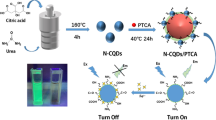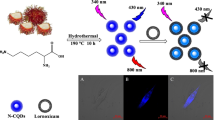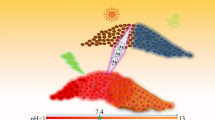Abstract
Novel colorimetric and ratiometric fluorometric dual-mode N, P-co-doped carbon nanodots, BPEI-CDs, for highly sensitive and selective detection of formaldehyde (FA) were successfully prepared from N-(phosphonomethyl)iminodiacetic acid (PMIDA) and branched polyethyleneimine (BPEI). The treatment of FA caused a remarkable linear enhancement of ratiometric fluorescence (F501 nm/F408 nm) in a wide range of 0–40 μM with a detection limit (LOD) of 0.47 μM (3σ/k), along with distinct color changes from colorless to light yellow. Mechanistic study shows that this electron-rich system, formed by the cooperative roles of N and P, promoted the FA-induced Schiff bases formation reaction, which contributed to the CD aggregation-induced emission (AIE) “turn-on” response and enhancement of π-conjugation-induced bathochromic behaviors. Furthermore, N, P-co-doped BPEI-CDs were successfully applied to the determination of FA in bean sprout samples. Using the standard addition method, the recoveries ranged from 96.9 to 101.8%, and the relative standard deviation (RSD) was in the range 2.23 to 3.21%. The application for intracellular FA sensing further verified that this novel nanoprobe may offer a new venue for the design of simple, low-cost, and sensitive biosensors.

Graphical abstract






Similar content being viewed by others
References
Bruemmer KJ, Green O, Su TA, Shabat D, Chang CJ (2018) Chemiluminescent probes for activity-based sensing of formaldehyde released from folate degradation in living mice. Angew Chem Int Ed 57:7508–7512
Ohata J, Bruemmer KJ, Chang CJ (2019) Activity-based sensing methods for monitoring the reactive carbon species carbon monoxide and formaldehyde in living systems. Acc Chem Res 52:2841–2848
Heck H, Casanova M (2004) The implausibility of leukemia induction by formaldehyde: a critical review of the biological evidence on distant-site toxicity. Regul Toxicol Pharmacol 40:92–106
Du P, Ran WG, Li WP, Luo LH, Huang XY (2019) Morphology evolution of Eu3+-activated NaTbF4 nanorods: a highly-efficient near-ultraviolet light-triggered red-emitting platform towards application in white light-emitting diodes. J Mater Chem C 7:10802–10809
Du P, Cai PQ, Li W.P., Luo, LH, Hou YP, Liu ZG (2019) Ratiometric optical thermometer based on the use of manganese (II)-doped Cs3Cu2I5 thermochromic and fluorescent halides. Microchim Acta 186: 730
Qu J, Xia Q, Ji W, Jing S, Zhu DR, Li L, Huang L, An ZF, Xin CQ, Ni Y, Li M, Jia JD, Song YL, Huang W (2018) A ferrocene∩europium assembly showing phototriggered anticancer activity and fluorescent modality imaging. 47: 1479-1487
El Sayed S, Pascual L, Licchelli M, Martínez-Máñez R, Gil S, Costero AM, Sancenón F (2016) Chromogenic detection of aqueous formaldehyde using functionalized silica nanoparticles. ACS Appl Mater Interfaces 8:14318–14322
Li HJ, Sun X, Xue F, Ou N, Sun BW, Qian DJ, Chen M, Wang D, Yang JH, Wang XY (2018) Redox induced fluorescence on-off switching based on nitrogen enriched graphene quantum dots for formaldehyde detection and bioimaging. ACS Sustain Chem Eng 6:1708–1716
Lin Q, Fan YQ, Gong GF, Mao PP, Wang J, Guan XW, Liu J, Zhang YM, Yao H, Wei TB (2018) Ultrasensitive detection of formaldehyde in gas and solutions by a catalyst preplaced sensor based on a pillar[5] arene derivative. ACS Sustain Chem Eng 6:8775–8781
Chaiendoo K, Boonchiangma S, Promarak V, Ngeontae W (2018) New sensitive strategy for formaldehyde sensing by in situ generation of luminescent silver nanoclusters. Colloid Polym Sci 29:1995–2004
Nandi S, Sharma E, Trivedi V, Biswas S (2018) Metal-organic framework showing selective and sensitive detection of exogenous and endogenous formaldehyde. Inorg Chem 57:15149–15157
Chaiendoo K, Sooksin S, Kulchat S, Promarak V, Tuntulani T, Ngeontae W (2018) A new formaldehyde sensor from silver nanoclusters modified Tollens’ reagent 255:41–48
Tang Y, Kong X, Xu A, Dong B, Lin W (2016) Development of a two-photon fluorescent probe for imaging of endogenous formaldehyde in living tissues. Angew Chem Int Ed 55:3356–3359
Yang H, Fang G, Guo M, Ning P, Feng Y, Yu H, Meng X (2018) A ratiometric two-photon fluorescent probe for selective detection of endogenous formaldehyde via aza-Cope reaction. Sens Actuators B: Chem 270:318–326
Cheng X, Xu J, Wang L, Xu GH, Wei FG, Cai YY, Hu Q, Cen Y (2019) A redox modulated ratiometric fluorometric method based on the use of dual-color carbon dots for determination of the activity of enzymes participating in ascorbic acid-related reactions. Microchim Acta 186:818
Wang J, Qiu Y, Li DQ, Liu XY, Jiang CX, Huang L, Wen HM, Hu J (2019) Ratiometric fluorometric and visual determination of cyanide based on the use of carbon dots and gold nanoclusters. Microchim Acta 186:809
Liu H, Sun Y, Li Z, Yang J, Aryee AA, Qu L, Du D, Lin Y (2019) Lysosome-targeted carbon dots for ratiometric imaging of formaldehyde in living cells. Nanoscale 11:8458–8463
Chen S, Jia Y, Zou GY, Yu YL, Wang JH (2019) A ratiometric fluorescent nanoprobe based on naphthalimide derivative-functionalized carbon dots for imaging lysosomal formaldehyde in HeLa cells. Nanoscale 11:6377–6383
Patel KD, Singh RK, Kim HW (2019) Carbon-based nanomaterials as an emerging platform for theranostics. Mater Horiz 6:434–469
Wang ZX, Jin X, Gao YF, Kong FY, Wang WJ, Wang W (2019) Fluorometric and colorimetric determination of hypochlorite using carbon nanodots doped with boron and nitrogen. Microchim Acta 186:328
Li Y, Lin H, Luo C, Wang Y, Jiang C, Qi R, Huang R, Travas-sejdic J, Peng H (2017) Aggregation induced red shift emission of phosphorus doped carbon dots. RSC Adv 7:32225–32228
Sun X, Bruckner C, Lei Y (2015) One-pot and ultrafast synthesis of nitrogen and phosphorus co-doped carbon dots possessing bright dual wavelength fluorescence emission. Nanoscale 7:17278–17282
Liu H, Li RS, Zhou J, Huang CZ (2017) Branched polyethylenimine-functionalized carbon dots as sensitive and selective fluorescent probes for N-acetylcysteine via an off-on mechanism. Analyst 142:4221–4227
Zhi B, Gallagher MJ, Frank BP, Lyons TY, Qiu TA, Da J, Mensch AC, Hamers RJ, Rosenzweig Z, Fairbrother DH, Haynes CL (2018) Investigation of phosphorous doping effects on polymeric carbon dots: fluorescence, photostability, and environmental impact. Carbon 129:438–449
Fu X, Sheng L, Yu Y, Ma M, Cai Z, Huang X (2018) Rapid and universal detection of ovalbumin based on N,O,P-co-doped carbon dots-fluorescence resonance energy transfer technology. Sens Actuators B: Chem 269:278–287
Wang J, Sheng R, Li H, Zhang Z, Wang N, Zhang Z, Huang CZ (2017) Highly fluorescent carbon dots as selective and visual probes for sensing copper ions in living cells via an electron transfer process. Biosens Bioelectron 97:157–163
Zhu S, Song Y, Zhao X, Shao J, Zhang J, Yang B (2015) The photoluminescence mechanism in carbon dots (graphene quantum dots, carbon nanodots, and polymer dots): current state and future perspective. Nano Res 8:355–381
Wei L, Tan W, Wang G, Li Q, Dong F, Guo Z (2019) The antioxidant and antifungal activity of chitosan derivatives bearing Schiff bases and quaternary ammonium salts. Carbohyd polym 226:115256–115266
Wang YA, Liu T, Zhong GQ (2019) Synthesis, characterization and applications of copper (II) complexes with Schiff bases derived from chitooligosaccharide and iodosubstituted salicylaldehyde. Carbohyd Polym 224:115151–115157
Jin H, Gui R, Wang Y, Sun J (2017) Carrot-derived carbon dots modified with polyethyleneimine and Nile blue for ratiometric two-photon fluorescence turn-on sensing of sulfide anion in biological fluids. Talanta 169:141–148
Zhou Z, Tian P, Liu X, Mei S, Zhou D, Li D, Jing P, Zhang W, Guo R, Qu S, Rogach AL (2018) Hydrogen peroxide-treated carbon dot phosphor with a bathochromic-shifted, aggregation-enhanced emission for light-emitting devices and visible light communication. Adv Sci 5:1800369–1800378
Gan Z, Xu H, Hao Y (2016) Mechanism for excitation-dependent photoluminescence from graphene quantum dots and other graphene oxide derivates: consensus, debates and challenges. Nanoscale 8:7794–7807
Chen W, Han J, Wang X, Liu X, Liu F, Wang F, Yu RQ, Jiang JH (2018) Aggregation-induced emission-based fluorescence probe for fast and sensitive imaging of formaldehyde in living cells. ACS Omega 3:14417–14422
Zhang Y, Yan B (2019) A portable self-calibrating logic detector for gradient detection of formaldehyde based on luminescent metal organic frameworks. J Mater Chem C 7:5652–5657
Chen HW, Li H, Song QH (2018) BODIPY-substituted hydrazine as a fluorescent probe for rapid and sensitive detection of formaldehyde in aqueous solutions and in live cells. ACS Omega 3:18189–18195
Acknowledgments
We gratefully acknowledge the financial support from funding for school-level research projects of Yancheng Institute of Technology (xjr2019021, xjr2019020) and the Natural Science Foundation of Jiangsu Province (BK20191041). This work also was supported by the National Natural Science Foundation of China (Grant No. 21671101).
Author information
Authors and Affiliations
Corresponding authors
Ethics declarations
Conflict of interest
The authors declare that they have no conflict of interest.
Additional information
Publisher’s note
Springer Nature remains neutral with regard to jurisdictional claims in published maps and institutional affiliations.
Electronic supplementary material
ESM 1
(DOCX 1107 kb)
Rights and permissions
About this article
Cite this article
Qu, J., Zhang, X., Liu, Y. et al. N, P-co-doped carbon dots as a dual-mode colorimetric/ratiometric fluorescent sensor for formaldehyde and cell imaging via an aminal reaction-induced aggregation process. Microchim Acta 187, 355 (2020). https://doi.org/10.1007/s00604-020-04337-0
Received:
Accepted:
Published:
DOI: https://doi.org/10.1007/s00604-020-04337-0




